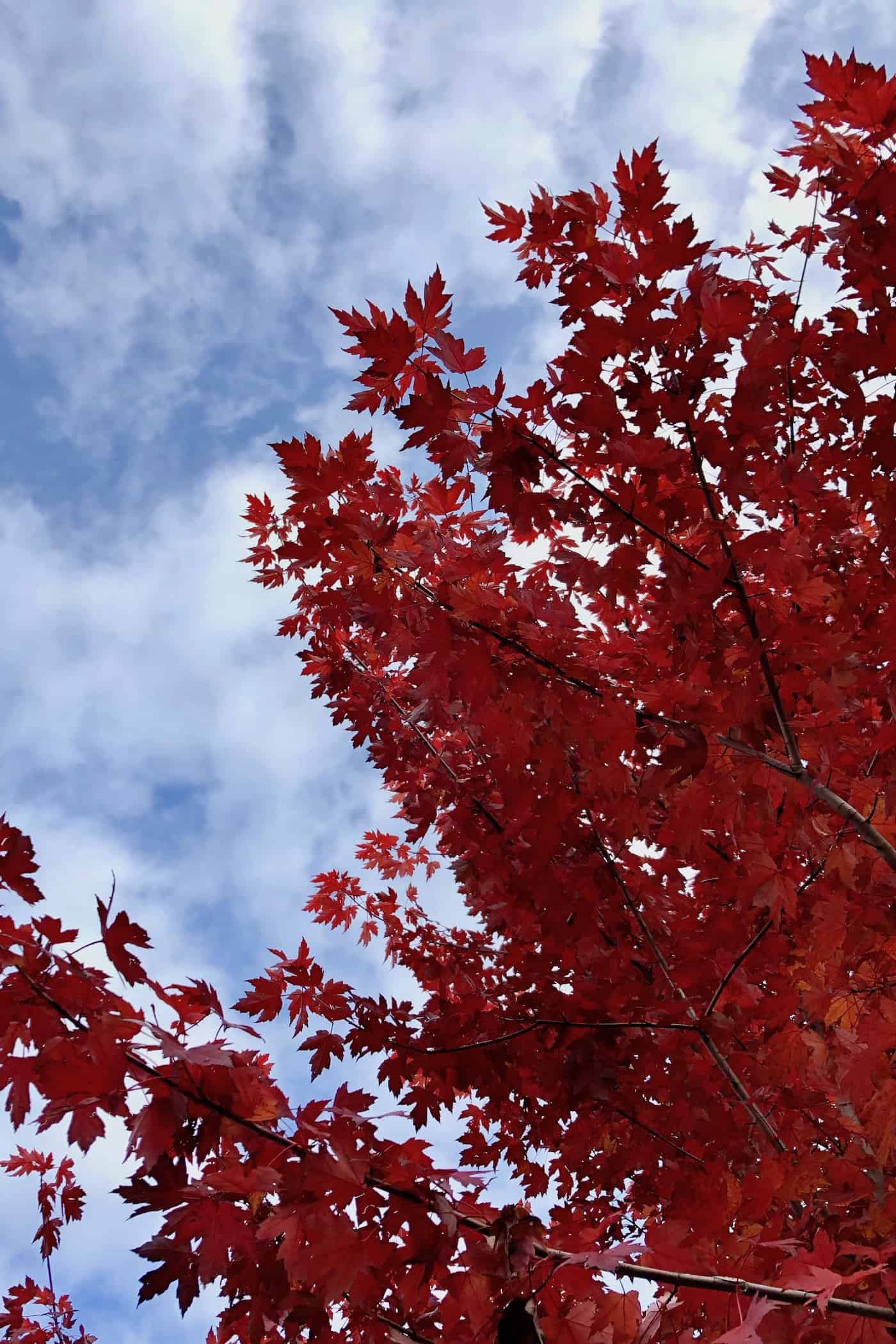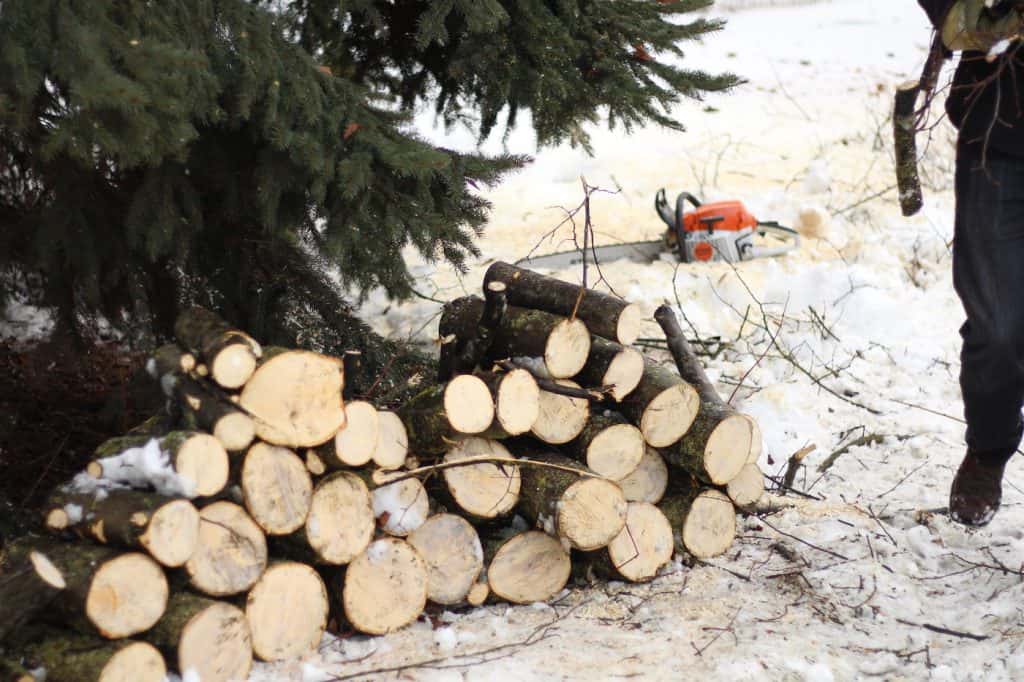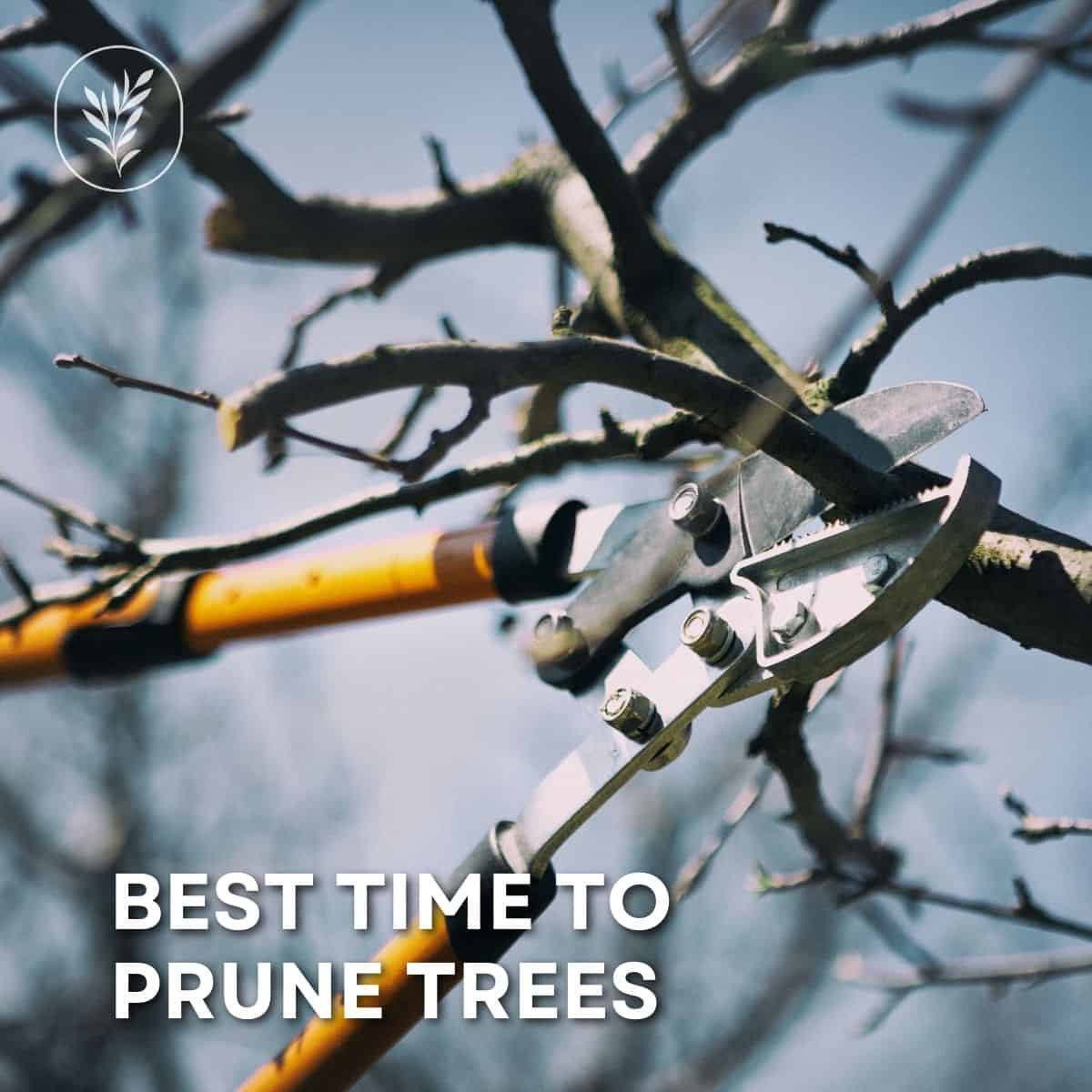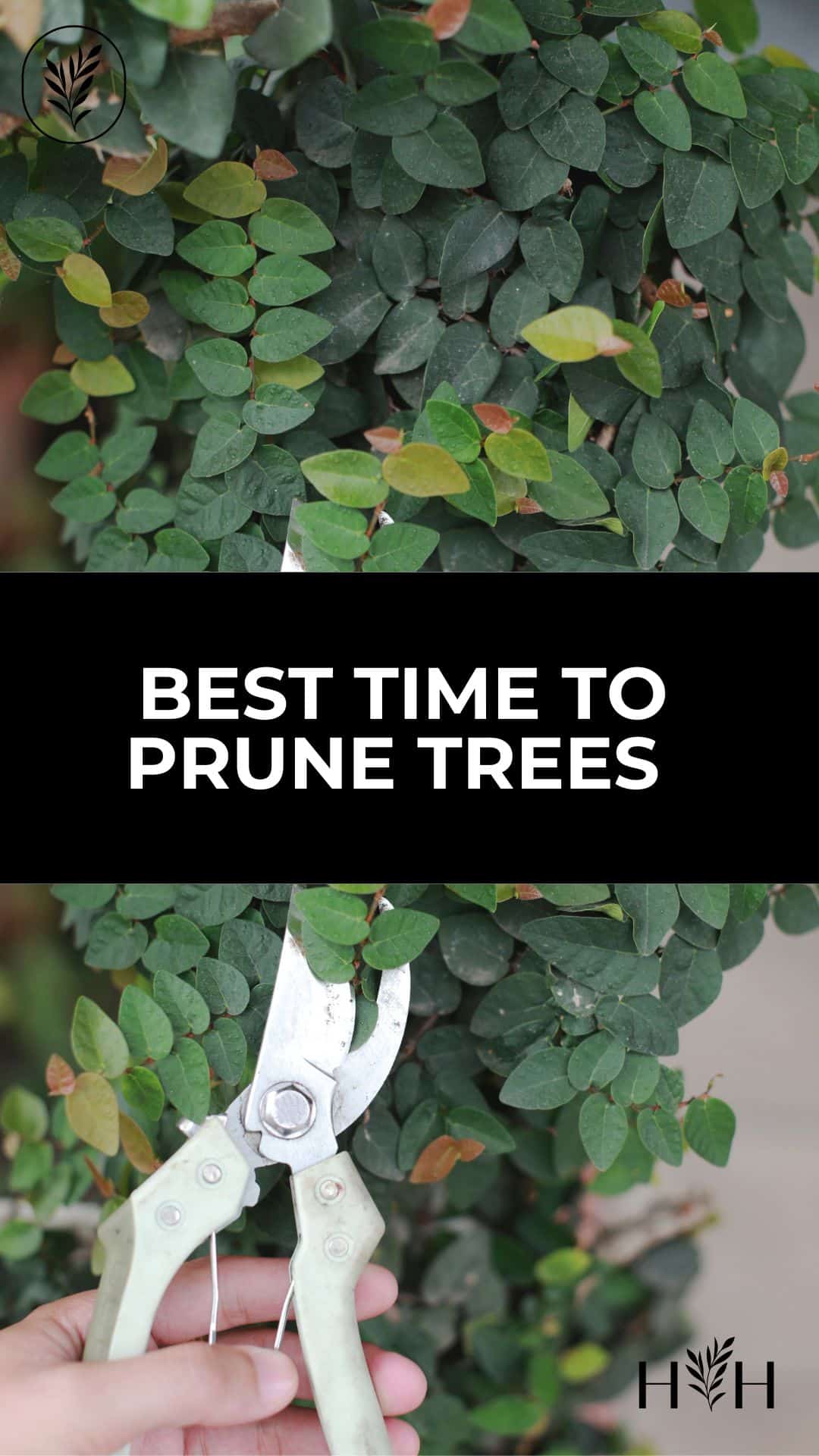Wondering when is the best time to prune trees? While you can get out the pruning tools any old time, there really is a preferred time of year for tree trimming.
The best time to prune most trees is at the end of winter while they are still dormant. February is often the best month for trimming trees back in temperate climates.
There are, of course, exceptions and intricacies to any rule in the world of tree care. Read on to learn more about when to prune specific types of trees in accordance with their annual growth cycles.

When should you cut back trees?
Knowing when to cut trees back helps you create an annual schedule for tree care. Most trees should be cut back at the end of winter. During late winter, trees are still dormant (not growing) but will soon have the vigor required to heal pruning cuts. Branches that are dead, damaged, or diseased can and should be removed at any time of year.
How a plant responds to pruning depends not only on how much you cut off a stem but also on when you do it.
Lee Reich, The Pruning Book, Plant Response to Pruning, Page 25, Taunton Press.
Trees are generally dormant in temperate zones from late fall until early spring. This means that a tree won’t be actively growing in the approximate period from November to March. Pruning during this time of winter dormancy sets trees up for healthy, robust growth in springtime and over the long term.
The best time to prune deciduous trees is late winter or early spring (February, March, and early April) before they begin to leaf out.
Iowa State University, Extension and Outreach
The best time to prune trees is during the late winter while the trees are dormant. Trees don’t yet have leaves at this time of year. Leaves make food for a plant, and stems store food for a plant. Removing leaves and stems means you’ve removed food storage and food production capability.
Late winter or early spring, before new growth begins, is generally considered the optimum time to prune most plants. This is when the plant’s wounds heal quickly, without threat of insect or disease infection.
Perdue University, Yard and Garden News, Late Winter Recommended for Pruning Chores, by Rosie Lerner.
Here are the main benefits of late winter tree trimming:
- Easy to see the
branch framework of the tree - Low risk of transmitting disease, bacteria, and pests
- Less sap flows in cold weather
- Wounds heal fastest when trees first come out of dormancy
Fall is generally the worst time to prune trees. Each fall, trees store food in their stems and roots. These energy stores keep trees alive in winter when they can’t make fresh food. The stored food also fuels the first growth of the tree in the spring.

Pruning trees in winter
Can you prune trees in winter? Trees can certainly be pruned in winter. In fact, winter is often the best time to prune trees. The trees are dormant and less vulnerable to pests and disease. Winter is also the easiest time to see the trunk and structural branch framework of the tree.
Tree pruning during freezing weather
Contrary to popular belief, plant damage is not generally caused by an unusually cold winter. Low temperature injury is more often associated with extreme temperature fluctuation than with prolonged cold weather.
The Morton Arboretum, Winter Injury to Trees and Shrubs
Most trees should be pruned during winter dormancy. Pruning before spring growth begins allows the grower to direct new growth as desired. To leave cuts open for a minimum amount of time, prune in the late winter instead of around Christmastime.
However, trees may be pruned at any time of the year, except when the wood is frozen. Pruning in late winter or early spring, just before the new growth emerges, is good timing for many trees. This leaves wound tissue exposed for a shorter period of time before sealing begins. Also, with no leaves on the trees, branching structure is more visible, helping with the decision-making process on pruning cuts.
University of Perdue Extension
If near 0° F temperatures are predicted, all pruning should stop at least 5 days before the cold weather is expected.
Good Fruit Grower, It’s Cold – So Can I Prune? by Lynn E. Long, Extension Horticulturalist with Oregon State University

Pruning deciduous trees in winter
Fruit trees are best pruned in late winter, as pruning in early winter can affect winter hardiness.
Pruning lessens winter hardiness to a small degree, so pruning in early winter can lead to winter injury when it is followed by severely cold temperatures. It takes two weeks for the tree to regain winter hardiness that is lost due to pruning.
University of Maine, Cooperative Extension
Some deciduous trees tend to bleed a lot of sap when they are pruned in late winter. While this isn’t generally bad for the tree, it can be unsightly. Although, I suppose bleeding sap is wonderful to see when making maple syrup!
Trees that bleed sap when pruned in late winter include maple, birch, willow, beech, and hornbeam. Sidenote – did you know that making birch syrup is becoming more common? To minimize bleeding consider the risks and benefits of delaying pruning to late spring. Fully unfurled leaves hold and contain

Another deciduous group of trees to avoid pruning in the winter are ornamental trees that flower in the springtime. These flowering trees grow their flower buds in the summer before they bloom. The flower buds overwinter on the tree. Pruning in the winter will result in fewer blooms in the spring because the flower buds will have been cut right off.
Pruning evergreen conifers in winter
Evergreen conifers also do well with late winter pruning. Spruce and fir don’t grow throughout the year, so pruning before growth begins will help direct vigor into desirable branches.
An excellent time to prune spruce and fir is late winter when they are still dormant. Spruce and fir possess side or lateral buds. The pruning cut should be just above a side bud or branch.
Iowa State University, Extension and Outreach
Pines should be saved for spring pruning after the new growth for the year has appeared.
Trees that are best pruned in late winter or early spring
- Apple
- Arborvitae
- Crepe Myrtle
- Dogwood
- Fir
- Hemlock
- Honey Locust
- Juniper
- Linden
- Oak
- Spruce
- Sumac
- Yew
Late winter and early spring can also be a great time to fertilize trees. Here is a detailed article on when to fertilize fruit trees.
As a rule, growth and wound closure are maximized if pruning takes place before the spring growth flush.
TreesAreGood.org, Pruning Mature Trees
Late winter is the best time to prune a tree to establish its central leader. Most trees are pruned to have one dominant trunk branch in the center of the tree that grows taller than other branches. This is the branch you’d put the star on if it were a Christmas tree. Late winter is the time to remove competing branches so the tree has only one central leader.
Because pruning reapportions a plant’s food reserves amongst fewer buds, the fewer remaining shoots that grow each get more “to eat” than they otherwise would have and thus grow with increased vigor.
Lee Reich, The Pruning Book, Effect of Time of Year

Pruning trees in spring
Trees that flower in summer should be pruned in winter or early spring (see
The best time to prune fruit trees is late February to early April. Fruit trees pruned in fall or early winter may be susceptible to winter injury.
Iowa State University, Extension and Outreach
Flowering trees that bloom in spring
Spring tree pruning is most commonly for early flowering trees, which are pruned right after they finish flowering. As spring pruning removes leaves that the tree depends on for photosynthesis, it’s best to
Most spring bloomers, such as lilacs, need only light pruning after they finish blooming for the year. Spring-blooming trees are among the last to be pruned in a calendar year, and they should be pruned as early as possible once the flowers start to fade.
Pine trees grow only in the spring. New spring growth is best pruned before the new needles mature. Removing buds from a pine tree takes away new growth points and can eventually result in dead branch stubs.
Plant growth can be reduced if live-branch pruning takes place during or soon after the initial growth flush. This is when trees have just expended a great deal of stored energy to produce roots, foliage, and early shoot growth so pruning at this time is usually not recommended due to the potential stresses. Stressed trees should not be pruned at this time.

Flowering trees to prune in late spring
Prune spring-flowering trees right after they flower. These trees will then have the rest of the summer to grow next year’s flower buds.
Trees and shrubs that bloom early in the growing season on last year’s growth should be pruned immediately after they finish blooming:
- Apricot
- Cherry
- Crabapple
- Forsythia
- Hawthorn
- Lilac
- Magnolia
- Pear
- Plum
- Redbud
- Serviceberry
Trees that bloom before the end of June should be pruned immediately after
University of Perdue Extension, Tree Pruning Essentials, by Lindsey Purcellflowering, since the current year’s bloom developed last year and overwintered in the bud. If pruned before blooming, the flower buds will be removed, eliminating flowering.
When to avoid spring pruning
Extensive pruning or pruning of weak trees should be minimized in the spring. Removing foliage that the tree has just spent its energy on can be discouraging for the tree! Mid-to-late spring is not a good time for heavy pruning.
Heavy pruning of live tissue just after the spring growth flush should be avoided, especially on weak trees. At that time, trees have just expended a great deal of energy to produce foliage and early shoot growth. Removal of a large percentage of foliage at that time can stress the tree.
TreesAreGood.org, Pruning Mature Trees
Oak trees are susceptible to several infections. These diseases are most easily transmitted in the peak spring growing period. Avoid all oak pruning in April, May, and June
Avoid pruning trees from the time of bud break until leaves have grown to full size.
PennState Extension, Pruning Landscape Trees

Pruning trees in summer
Summer tree pruning is limited to several specific situations. Summer pruning removes leaves that would otherwise be used for photosynthesis. Because pruning removes parts of the tree that are actively used for energy production, summer branch removal should be done cautiously.
Spring or summer pruning increases chances for spread and infection of bacterial diseases such as fireblight.
University of Perdue Extension, Tree Pruning Essentials, by Lindsey Purcell
A tree’s response to summer pruning depends on its health. Summer pruning can spell the end for a weak plant. A hardy plant might not be bothered by it at all. A wet spell after summer pruning can also encourage buds to bloom in early fall that otherwise would have stayed dormant over the winter.
Minimize any pruning in late summer or early fall, because that can promote a late flush of new growth more susceptible to cold damage or can delay dormancy on species such as elms and maples. Also, reconsider any pruning activity if the tree is stressed from drought.
University of Perdue Extension, Tree Pruning Essentials, by Lindsey Purcell
Summer pruning of deciduous trees
Deciduous trees are generally best pruned in late winter or early spring. Some unwanted branches, however, only make themselves apparent in the summertime. This includes the vertical waterspouts that tend to shoot upwards from the branches of fruit trees.
Summer pruning [of fruit trees] in late July or August is another time when pruning can be performed, but severe pruning at this time will weaken the tree. Therefore, the majority of pruning should be done during winter or spring.
University of Maine, Cooperative Extension
To cut back water sprouts off fruit trees, take off the whole branch including the base of buds. This is most easily done in the summer when the water sprouts are supple. They tend to get woody by autumn and become harder to remove. Don’t leave buds at the base or there will be a whole new crop of water sprouts in the fall.
summer is the time to remove a stem to let light in among the branches (to color up ripening apples or peaches, for example) or to remove a stem that is vigorus and in the wrong place.
Lee Reich, The Pruning Book, Effect of Time of Year
Pruning evergreens in the summer
Some evergreens grow throughout the growing season (not just in the spring). This includes yew, juniper, arborvitae, and hemlock. These evergreens can be pruned until mid-summer. This characteristic is especially useful when these trees are grown in hedge form instead of in their standard natural tree form.
Pines are also pruned in early summer. This is because pines put on their growth in the spring. Early summer pruning can help control their size.
Pines are pruned in early June to early July when the new growth is in the “candle” stage. Pinching or snapping off one-half to two-thirds of the candle reduces the pine’s annual growth.
Iowa State University, Extension and Outreach, The Proper Time to Prune, by Richard Jauron, Department of Horticulture.
Trees to consider for a light summer pruning
These trees can be considered for light pruning in early summer to mid-summer. Remember to save the heavier pruning for dormancy!
- Apple
- Arborvitae
- Juniper
- Hemlock
- Peach
- Pear
- Pine
- Yew

Pruning trees in fall
Fall is perhaps the worst time to prune trees. While trees could be pruned in the fall, any significant pruning is should generally be delayed until winter. Concentrate instead on winterizing herbaceous perennials and raking up autumn leaves to make lovely homemade leaf compost. Fall is not the right time to trim trees. Go apple picking instead!
Although immediate regrowth rarely occurs after late summer or autumn pruning, cells right at the cut are stirred into activity to close off the wound. Active cells are liable to be injured by cold weather, which is a reason to avoid pruning in late summer or autumn except in climates with mild winters or with plants that are very hardy to cold.
Lee Reich, The Pruning Book, Effect of Pruning on Time of Year
Fall pruning stimulates plant cells. Even if regrowth is delayed until springtime, fall pruning still affects the winter hardiness of the tree. Wait until temperatures drop along with sap activity. Let the trees drift off into dormancy without bothering them while they try to go to sleep.
Pruning in November tends to reduce the cold hardiness of woody plants until late February, so the effects of pruning are fairly long-lasting.
PennState Extension, Tree Fruit Cold Hardiness – Effect of Pruning
While fall pruning is generally to be avoided, autumn is a good time to take a look at your landscape trees and consider how they might fare during the winter. Any weakened branches should be removed in the fall before they become increasingly vulnerable to storm damage. Damaged branches can and should be removed any time of year (even in the fall).
So yes! There are some types of pruning that can be done any time of year…

Tree pruning that can be done any time of the year
Certain types of tree pruning can be done any time of year. Here are some pruning activities that should be done as soon as possible, whatever the season:
- Removal of branches for safety reasons
- Weak or over-extended branches
- Removal of dead, damaged, or diseased limbs
- Light hand pruning of small branches (for shape)
- Light pruning of branches that cross other branches
- Light hand pruning of hedges (for shape)
- Basal sprouts at the bottom of the tree trunk
- Vertical water sprouts (especially on fruit trees)
Pruning in any of the above scenarios can often be done

Tips for pruning trees during the dormant season
Here are some general tips for pruning trees during dormancy:
- Start by considering safety. Wait until hazards from snow and ice have passed.
- Always use clean sharp tools!
- Pruning dwarfs plants to some extent any time of year.
- Remember to prune for safety and health, as well as aesthetics.
- Consider the purpose of the tree and imagine the leaf canopy before getting out the pruning tools.
- Cuts during dormancy wound the plant, even though the tree isn’t actively growing.
- Removing live stems removes stored food for the tree, even when the tree is dormant.
- Shortening a one-year-old branch stimulates more growth than pruning an old branch.
- Pruning is less harmful when cuts are an inch or less in diameter.
- Don’t remove too many live branches at once:
- Prioritize the removal of branches that are more than 1/2 the diameter of the main tree trunk.
- Branches that compete with the central leader are good candidates for removal.
- Leave at least 2/3 of the height of the trunk with branches on it.
- Try not to make more than 5 or 6 big pruning cuts each year.
- Don’t remove more than 1/3 of the branches in one year.









